使用通用后处理器(POST1)可观察整个模型或模型的一部分在某一时间点(或频率)上针对指定载荷组合时的结果。
7.2.1 数据文件选项
如果用户已经完成求解并且已经保存,则用户可以在通用后处理中直接读入结果文件,然后可进行其他后处理操作。用户可用下列方法打开“Data and File Options(数据和文件选项)”对话框。
GUI:Main Menu︱General Postproc︱Date&File Opts,打开图7-1所示的“数据和文件选项”对话框。该对话框中主要包括两个选项:需读入的数据类型(Data to be read)和读入的结果文件类型(Results file to be read)。用户可以读入以下数据类型:所有数据项(All items)、基本数据项(Basic items)、节点自由度结果(Nodal DOF solution)、节点反力载荷(Elem reaction load)、单元求解结果(Elem solution)、单元节点载荷(Elem nodal loads)、单元节点应力(Elem nodal stresses)、单元弹性应变(Elem elastic strain)、单元热应变(Elem thermal strain)、单元塑性应变(Elem plastic strain)、单元蠕变应变(Elem creep strain)、单元节点梯度(Elem nodal gradients)、单元节点通量(Elem nodal flux)和混合数据单元(misc elem data)。用户可以读入单个结果文件(Read single result file)或读入多个CMS结果文件(Read multiple CMS result files)。
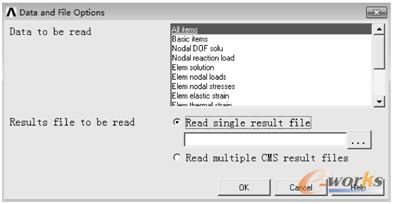
图7-1 “数据和文件选项”对话框
7.2.2 查看结果总汇
用户可以通过以下路径查看结果总汇,包括模态分析中的固有频率和瞬态分析或非线性分析中的载荷步和子步。GUI:Main Menu︱General Postproc︱Results Summary,弹出图7-2所示的“SET.LIST Command(结果汇总)”对话框。该对话框中包括数据列表号(SET)、时间/频率(TIME/FREQ)列表、载荷步(LOAD STEP)列表、子步(SUBSTEP)列表和积累量(CUMULATIVE)列表。
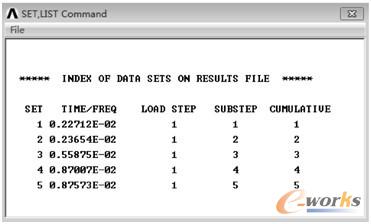
图7-2 “结果汇总”对话框
7.2.3 读入结果
图7-3所示为通用后处理中的读入结果列表,用户使用读入结果列表可以进行以下操作。
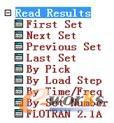
图7-3 读入结果列表
(1)读入结果汇总中的第一个结果
GUI:Main Menu︱General Postproc︱Read Results︱First Set。
(2)读入结果汇总中的下一个结果
GUI:Main Menu︱General Postproc︱Read Results︱Next Set。
(3)读入结果汇总中的前一个结果
GUI:Main Menu︱General Postproc︱Read Results︱Previous Set。
(4)读入结果汇总中的最后一个结果
GUI:Main Menu︱General Postproc︱Read Results︱Last Set。
(5)拾取结果汇总中的任意结果
GUI:Main Menu︱General Postproc︱Read Results︱By Pick,弹出图7-4所示的“Results File: file.rst(结果文件显示)”对话框,用户使用鼠标左键选择结果汇总中的任意子步结果,然后单击Read按钮。
(6)通过载荷步号读入结果
GUI:Main Menu︱General Postproc︱Read Results︱By load Step,弹出图7-5所示的“Read Results by Load Number(通过载荷步号读入结果)”对话框。该对话框中包括4个选项:读入结果来源(Read results for)、载荷步号(Load step number)、子步号(Substep number)和比例因子(Scale factor)。
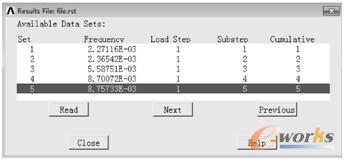
图7-4 “结果文件显示”对话框
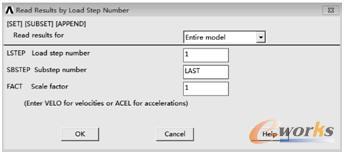
图7-5 “通过载荷步号读入结果”对话框
(7)通过时间/频率读入结果
GUI:Main Menu︱General Postproc︱Read Results︱By Time/Freq,弹出图7-6所示的“Read Results by Time or Frequency(通过时间或频率读入结果)”对话框,该对话框包括5个选项:读入结果来源(Read results for)、时间或频率点值(Value of time or freq)、读入时间点或靠近时间点的结果(Results at or near TIME)、比例因子(Scale factor)和圆周位置(Circumferential location)。
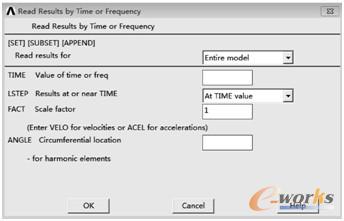
图7-6 “通过时间或频率读入结果”对话框
(8)通过数据列表号读入结果
GUI:Main Menu︱General Postproc︱Read Results︱By Set Number,弹出图7-7所示的“Read Results by Data Set Number(通过数据列表号读入结果)”对话框。该对话框包括4个选项:读入结果来源(Read results for)、数据列表号(Data set number)、比例因子(Scale factor)和圆周位置(Circumferential location)。
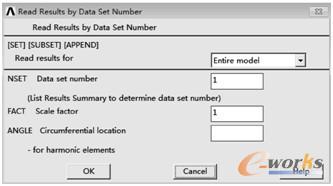
图7-7 “通过数据列表号读入结果”对话框






